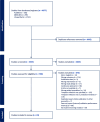Systematic evaluation of machine learning models for postoperative surgical site infection prediction
- PMID: 39666725
- PMCID: PMC11637340
- DOI: 10.1371/journal.pone.0312968
Systematic evaluation of machine learning models for postoperative surgical site infection prediction
Abstract
Background: Surgical site infections (SSIs) lead to increased mortality and morbidity, as well as increased healthcare costs. Multiple models for the prediction of this serious surgical complication have been developed, with an increasing use of machine learning (ML) tools.
Objective: The aim of this systematic review was to assess the performance as well as the methodological quality of validated ML models for the prediction of SSIs.
Methods: A systematic search in PubMed, Embase and the Cochrane library was performed from inception until July 2023. Exclusion criteria were the absence of reported model validation, SSIs as part of a composite adverse outcome, and pediatric populations. ML performance measures were evaluated, and ML performances were compared to regression-based methods for studies that reported both methods. Risk of bias (ROB) of the studies was assessed using the Prediction model Risk of Bias Assessment Tool.
Results: Of the 4,377 studies screened, 24 were included in this review, describing 85 ML models. Most models were only internally validated (81%). The C-statistic was the most used performance measure (reported in 96% of the studies) and only two studies reported calibration metrics. A total of 116 different predictors were described, of which age, steroid use, sex, diabetes, and smoking were most frequently (100% to 75%) incorporated. Thirteen studies compared ML models to regression-based models and showed a similar performance of both modelling methods. For all included studies, the overall ROB was high or unclear.
Conclusions: A multitude of ML models for the prediction of SSIs are available, with large variability in performance. However, most models lacked external validation, performance was reported limitedly, and the risk of bias was high. In studies describing both ML models and regression-based models, one modelling method did not outperform the other.
Copyright: © 2024 van Boekel et al. This is an open access article distributed under the terms of the Creative Commons Attribution License, which permits unrestricted use, distribution, and reproduction in any medium, provided the original author and source are credited.
Conflict of interest statement
I have read the journal’s policy and the authors of this manuscript have the following competing interests: B.F. Geerts declares to be shareholder and owner of Healthplus.ai S.L. van der Meijden, M. Wiewel, E.B. Nieswaag, K.F.T. Jochems, J. Holtz, A. van IJlzinga Veenstra, and J. Reijman declare to be an employee of Healthplus.ai. This does not alter our adherence to PLOS ONE policies on sharing data and materials.
Figures




References
-
- European Centre for Disease Prevention and Control. Healthcare-associated infections: surgical site infections. ECDC. Annual epidemiological report for 2018–2020. Stockholm; 2023.
Publication types
MeSH terms
LinkOut - more resources
Full Text Sources

